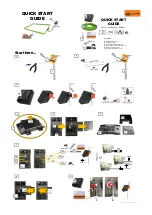
ROC800-Series Instruction Manual
2-2
Installation and Use
Revised July-2017
2.1.1 Environmental Requirements
Always install the ROC800 in a user-supplied building or enclosure to
protect it from direct exposure to rain, snow, ice, blowing dust or debris,
and corrosive atmospheres. If you install the ROC800 outside of a
building, it must be placed in a National Electrical Manufacturer’s
Association (NEMA) 3 or higher rated enclosure to ensure the necessary
level of protection.
Note
:
In salt spray environments, it is especially important to ensure
that the enclosure—including all entry and exit points—is sealed
properly.
The ROC800 operates over a wide range of temperatures. However, in
extreme climates it may be necessary to provide temperature-controlling
devices to maintain stable operating conditions. In extremely hot
climates, a filtered ventilation system or air conditioning may be
required. In extremely cold climates, it may be necessary to provide a
thermostatically controlled heater in the same enclosure as the ROC800.
To maintain a non-condensing atmosphere inside the ROC800 enclosure
in areas of high humidity, it may be necessary to add heat or
dehumidification.
2.1.2 Site Requirements
When locating the ROC800 on the site, careful consideration can help
reduce future operational problems. Consider the following items when
choosing a location:
Local, state, and federal codes often place restrictions on locations
and dictate site requirements. Examples of these restrictions are fall
distance from a meter run, distance from pipe flanges, and
hazardous area classifications. Ensure that all code requirements are
met.
Choose a location for the ROC800 to minimize the length of signal
and power wiring.
Locate ROC800s equipped for radio communications so the antenna
has an unobstructed signal path. Antennas should not be aimed into
storage tanks, buildings, or other tall structures. If possible, antennas
should be located at the highest point on the site. Overhead
clearance should be sufficient to allow the antenna to be raised to a
height of at least twenty feet.
To minimize interference with radio communications, choose a
location for the ROC800 away from electrical noise sources, such as
engines, large electric motors, and utility line transformers.
Choose a location for the ROC800 away from heavy traffic areas to
reduce the risk of being damaged by vehicles. However, provide
adequate vehicle access to aid monitoring and maintenance.
















































